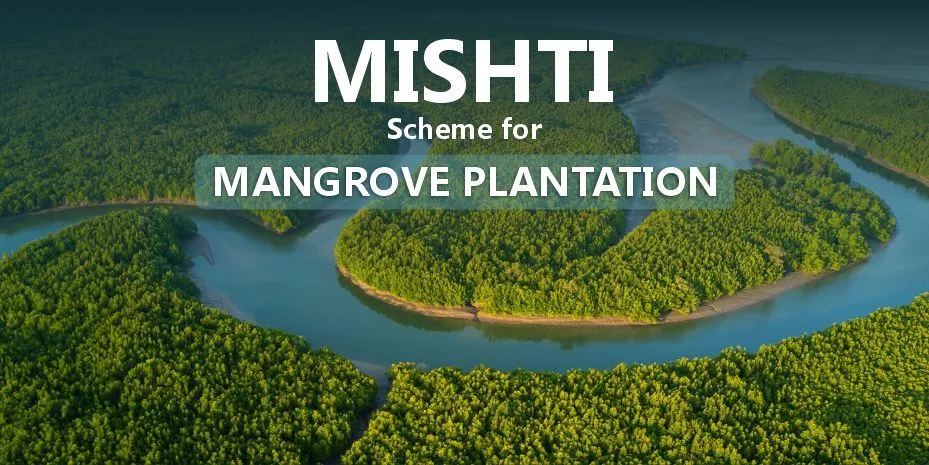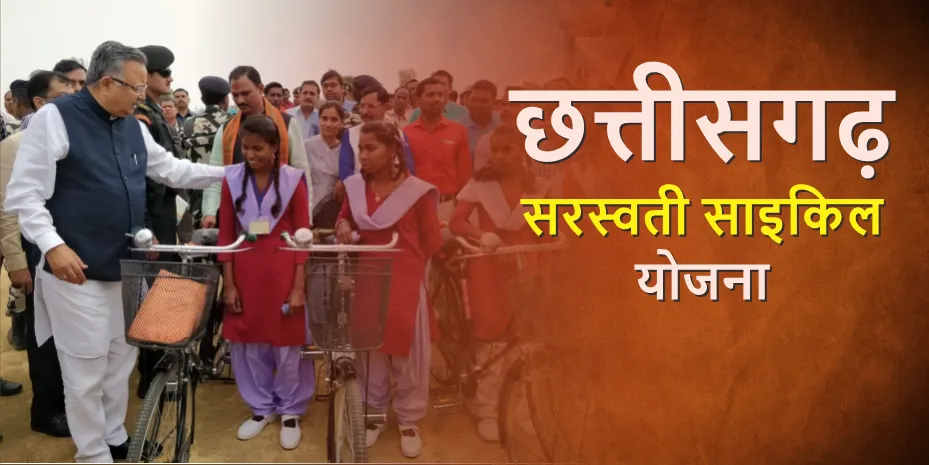The MISHTI (Mangrove Initiative for Shoreline Habitats & Tangible Incomes) scheme is a government-led initiative aimed at increasing the mangrove cover along the coastline and on saltpan lands. The scheme is primarily focused on the Sundarbans delta, Hoogly Estuary in West Bengal, India and other bay parts of country, but also includes other wetlands in the country. The objective of the scheme is to conserve and restore the mangrove ecosystem, which is critical to mitigating the effects of climate change, preventing coastal erosion, and sustaining local livelihoods.
Under the MISHTI scheme, the government is providing financial assistance to local communities to undertake mangrove plantation activities. The scheme also involves awareness campaigns to educate people about the importance of mangroves and their role in protecting the environment. The plantation activities are carried out in a participatory manner, involving local communities and NGOs, to ensure sustainability and community ownership of the initiative. Overall, the MISHTI scheme is a significant step towards promoting sustainable development and protecting the vulnerable coastal areas of India.
Contents
- 1 What is MISHTI Scheme (Full-Form)?
- 2 Impact of the MISHTI Scheme 2023 For Country’s Farmers
- 2.1 Challenges and Future of the MISHTI Scheme 2023 in India
- 2.2 Important Links for MISHTI Scheme Mangrove plantation
- 2.3 FAQs for MISHTI Scheme 2023 for Mangrove Plantation
- 2.3.1 What is the full form of the MISHTI scheme?
- 2.3.2 What is the objective of the MISHTI scheme?
- 2.3.3 Which ministry is responsible for implementing the MISHTI scheme?
- 2.3.4 What is the role of the local communities in the implementation of the MISHTI scheme?
- 2.3.5 What technical assistance is provided to the local communities under the MISHTI scheme?
- 2.3.6 What is the impact of the MISHTI scheme on the mangrove ecosystems in India?
- 2.3.7 Is the MISHTI scheme applicable only to India, or can it be replicated in other countries?
What is MISHTI Scheme (Full-Form)?
Mangrove forests are an essential component of the coastal ecosystem, providing a variety of ecological and socioeconomic benefits. However, these forests are under threat from various anthropogenic and natural factors such as deforestation, urbanization, climate change, and natural disasters. To combat these threats and conserve the mangrove ecosystem, the Indian government has launched the MISHTI (Mangrove Initiative for Shoreline Habitats & Tangible Incomes) scheme.
The MISHTI scheme aims to increase the mangrove cover along the coastline and on saltpan lands in India, focusing primarily on the Sundarbans delta and the Hoogly Estuary in West Bengal. The scheme adopts a participatory approach, involving local communities and NGOs to undertake mangrove plantation activities. The ultimate goal of the scheme is to sustainably manage the mangrove ecosystem, preserve biodiversity, and improve the resilience of coastal communities to natural disasters. This article aims to provide an in-depth understanding of the MISHTI scheme for mangrove plantations, highlighting the importance of mangrove forests and their role in the coastal ecosystem.
Overview of MISHTI Scheme for Mangrove Plantation
Here’s an overview of the MISHTI scheme for mangrove plantation along the coastline and on salt pan lands in India in a table format:
| Aspect | Details |
|---|---|
| Full form | Mangrove Initiative for Shoreline Habitats & Tangible Incomes |
| Objective | To conserve and restore mangrove ecosystems along the Indian coastline, while also improving the socio-economic condition of local communities |
| Implementing Agency | Ministry of Environment, Forest and Climate Change (MoEFCC) |
| Partners | Mangroves for the Future (MFF), Indian Council of Forestry Research and Education (ICFRE), National Biodiversity Authority (NBA), United Nations Development Programme (UNDP) |
| Funding | 80% of the project cost is borne by the Government of India, while the remaining 20% is contributed by the respective State Governments |
| Target Area | Coastal areas and salt pan lands in the States of Gujarat, Maharashtra, Goa, Karnataka, Kerala, Tamil Nadu, and West Bengal |
| Community Participation | Local communities are actively involved in the implementation of the scheme, with technical assistance and training provided by ICFRE |
| Impact | Increased mangrove cover in target areas, improvement in socio-economic conditions of local communities, mitigation of the impact of natural disasters |
| Future Plans | Expansion of the scheme to other coastal areas in the country, promotion of alternative livelihood options for local communities |
Background of the MISHTI Scheme & Implementation
The MISHTI (Mangrove in Sundarbans, Hoogly Estuary, and other wetlands) scheme was launched by the Ministry of Environment, Forest and Climate Change (MoEFCC) in 2023 to increase the mangrove cover along the coastline and on salt pan lands in India. In Union Budget 2023-24 finance minister of India Smt. Nirmala Sitharaman Ji re-launched this scheme to implement in the whole country. In starting scheme was focused on the Sundarbans delta and the Hoogly Estuary in West Bengal, two areas that have experienced a significant loss of mangrove cover in recent years.
After the re-announcement of this scheme, it will help all farmers in the country. The MISHTI scheme was inspired by the successful mangrove plantation efforts undertaken in the Sundarbans by the local community, with the support of various NGOs and the Forest Departments. The MoEFCC recognized the importance of these efforts in conserving the mangrove ecosystem and decided to scale up the plantation activities under the MISHTI scheme.
The government has provided significant funding and support to the MISHTI scheme to ensure its successful implementation. The scheme is funded under the National Adaptation Fund for Climate Change (NAFCC), a flagship scheme of the government that aims to fund climate change adaptation projects. The government has also allocated funds under the Compensatory Afforestation Fund Management and Planning Authority (CAMPA) for the plantation of mangroves on salt pan lands.
Objectives of MISHTI Scheme 2023
The objectives of the MISHTI scheme are multi-faceted, aiming to conserve the mangrove ecosystem, promote sustainable livelihoods for local communities, and enhance the resilience of the coastal ecosystem. The scheme’s objectives are as follows:
- Increase the mangrove cover along the coastline and on salt pan lands in India, with a particular focus on the Sundarbans delta and the Hoogly Estuary in West Bengal.
- Promote community-based mangrove plantation and restoration activities, involving local communities and NGOs in the plantation and maintenance of mangrove forests.
- Improve the ecological resilience of the coastal ecosystem by protecting against erosion, storm surges, and sea-level rise.
- Enhance the biodiversity of the mangrove ecosystem and conserve threatened and endangered species.
- Generate sustainable livelihood opportunities for local communities, such as ecotourism, crab farming, and honey production.
The MISHTI scheme is an ambitious initiative that aims to address the threats to the mangrove ecosystem while providing sustainable livelihood opportunities to local communities. The scheme’s objectives are aligned with the global Sustainable Development Goals (SDGs) and the National Action Plan on Climate Change (NAPCC), reflecting the government’s commitment to sustainable development and climate change adaptation.
Implementation of the MISHTI Scheme 2023 in Country
The implementation of the MISHTI scheme involves the active participation of local communities in mangrove plantation and conservation activities. The scheme recognizes the crucial role of local communities in conserving the mangrove ecosystem, and therefore, aims to involve them in all aspects of the project.
The following are the key components of the implementation strategy:
- Role of the Local Communities:
The MISHTI scheme 2023 emphasizes the participation of local communities in mangrove plantation and conservation activities. The scheme involves the formation of Joint Forest Management Committees (JFMCs) comprising local villagers, NGOs, and the forest department. The JFMCs are responsible for identifying suitable sites for mangrove plantations, selecting species, and ensuring the proper maintenance of the plantation.
- Technical Assistance:
The local communities are provided with technical assistance and training in all aspects of mangrove plantation and conservation. The technical assistance includes site selection, seed collection, nursery management, plantation techniques, and post-plantation care. The communities are also provided with tools and equipment required for plantation and maintenance.
- Health Care Facilities:
The MISHTI scheme recognizes the importance of the health and well-being of the local communities involved in the plantation activities. The scheme provides health care facilities to the local communities, including regular health check-ups, distribution of medicines, and training in basic health care.
- Social Mobilization:
The MISHTI scheme involves social mobilization activities aimed at creating awareness about the importance of mangrove conservation among local communities. The social mobilization activities include awareness campaigns, street plays, and community meetings. The scheme also aims to promote eco-tourism in the mangrove forests, generating sustainable livelihood opportunities for the local communities.
The implementation of the MISHTI scheme has been successful in achieving its objectives. The active participation of local communities in mangrove plantation and conservation activities has resulted in the successful establishment of mangrove forests in the Sundarbans delta and the Hoogly Estuary. The scheme has also generated sustainable livelihood opportunities for local communities and enhanced the ecological resilience of the coastal ecosystem. The MISHTI scheme 2023 serves as an excellent example of community-based natural resource management and highlights the importance of involving local communities in conservation activities.
Impact of the MISHTI Scheme 2023 For Country’s Farmers
The MISHTI scheme has had a significant impact on the socio-economic condition of the local communities involved in mangrove plantations and conservation activities. The scheme has generated sustainable livelihood opportunities for the local communities and has helped in the development of local economies.
The following are the key impacts of the MISHTI scheme 2023:
- Improvements in the Socio-Economic Condition of Local Communities:
The MISHTI scheme has provided a source of income for local communities through the promotion of eco-tourism and the sale of mangrove-based products. The scheme has also resulted in an improvement in the education and healthcare facilities in the region, leading to an overall improvement in the socio-economic condition of the local communities.
- Increase in the Number of Mangrove Forests:
The MISHTI scheme has resulted in a significant increase in the number of mangrove forests in the coastal areas of the country. The scheme has helped in the rehabilitation of degraded mangrove ecosystems and has contributed to the conservation of biodiversity in the region. The mangrove forests have also helped in the mitigation of climate change impacts by sequestering carbon and reducing the impacts of sea-level rise.
- Mitigation of the Impact of Natural Disasters:
The MISHTI scheme has helped in the mitigation of the impact of natural disasters such as cyclones, floods, and storms in coastal areas. The mangrove forests act as natural barriers that protect the coastal communities from the impact of natural disasters by reducing the intensity of winds and waves. The scheme has helped in reducing the damage caused by natural disasters and has helped in the quick recovery of the affected communities.
The MISHTI scheme 2023 has been successful in achieving its objectives of conserving mangrove ecosystems, generating sustainable livelihood opportunities for local communities, and enhancing the resilience of the coastal ecosystem. The scheme serves as an excellent example of community-based natural resource management and highlights the importance of involving local communities in conservation activities.
Challenges and Future of the MISHTI Scheme 2023 in India
Despite the success of the MISHTI scheme, there have been several challenges in implementing the scheme. Some of the key challenges are:
- Lack of Awareness: One of the major challenges faced in implementing the scheme is the lack of awareness among the local communities about the importance of mangrove forests and their role in the coastal ecosystem.
- Funding Constraints: The implementation of the scheme requires significant financial resources, and funding constraints have been a major challenge.
- Land Use Conflicts: Land use conflicts have been a significant challenge in the implementation of the scheme. There have been instances where the land identified for mangrove plantation has been used for other purposes.
To overcome these challenges, the following strategies can be adopted:
- Community Mobilization and Awareness: Community mobilization and awareness-raising activities can be conducted to sensitize the local communities about the importance of mangrove forests and the benefits of the MISHTI scheme.
- Public-Private Partnerships: Public-private partnerships can be explored to mobilize additional funding for the implementation of the scheme.
- Land Use Planning: Land use planning and management can be done in a participatory manner to ensure that land identified for mangrove plantation is not used for other purposes.
In terms of the future of the MISHTI scheme, the following are the key plans:
- Expansion of the Scheme: The MISHTI scheme is currently being implemented in select areas, and there are plans to expand the scheme to other coastal areas.
- Promotion of Eco-tourism: There are plans to promote eco-tourism in the region to generate additional revenue for the local communities.
- Capacity Building: Capacity building activities will be conducted to enhance the technical and entrepreneurial skills of the local communities involved in mangrove plantation and conservation activities.
The MISHTI scheme 2023 has been successful in achieving its objectives, but there are several challenges that need to be addressed to ensure the sustainability of the scheme. The future plans for the scheme focus on expanding the scheme and promoting eco-tourism while enhancing the capacity of the local communities involved in the scheme.
Important Links for MISHTI Scheme Mangrove plantation
These links can provide more information on the MISHTI scheme 2023 and its implementation, as well as related activities and initiatives.
- Ministry of Environment, Forest and Climate Change (MoEFCC) website: http://moef.gov.in/
The MISHTI scheme is implemented by the MoEFCC, and its website provides information on the scheme, its objectives, and progress reports.
- Mangroves for the Future (MFF) website: http://www.mangrovesforthefuture.org/
The MFF is a regional initiative that works towards the conservation and restoration of mangrove ecosystems in the Asia-Pacific region. The MISHTI scheme is a part of the MFF, and its website provides information on the scheme and other related activities.
- Indian Council of Forestry Research and Education (ICFRE) website: https://icfre.gov.in/
The ICFRE is a premier research organization in the field of forestry and natural resource management in India. They have played a key role in providing technical assistance and training to the local communities under the MISHTI scheme.
- National Biodiversity Authority (NBA) website: http://nbaindia.org/
The NBA is a statutory body established under the Biological Diversity Act, of 2002, to conserve India’s biodiversity. The NBA has been involved in the implementation of the MISHTI scheme, and its website provides information on the scheme and related activities.
- United Nations Development Programme (UNDP) India website: https://www.undp.org/india
The UNDP has supported the implementation of the MISHTI scheme, and its website provides information on the scheme, its objectives, and its impact.
FAQs for MISHTI Scheme 2023 for Mangrove Plantation
Here are a few frequently asked questions and answers related to this Mishti Scheme 2023:
What is the full form of the MISHTI scheme?
MISHTI stands for “Mangrove Initiative for Shoreline Habitats & Tangible Incomes”.
What is the objective of the MISHTI scheme?
The MISHTI scheme aims to conserve and restore mangrove ecosystems in the coastal areas of India while improving the socio-economic condition of the local communities through sustainable livelihood opportunities.
Which ministry is responsible for implementing the MISHTI scheme?
The Ministry of Environment, Forest and Climate Change (MoEFCC), Government of India is responsible for implementing the MISHTI scheme.
What is the role of the local communities in the implementation of the MISHTI scheme?
The local communities play a crucial role in the implementation of the MISHTI scheme. They are involved in all aspects of the scheme, including mangrove plantation, conservation, and management, as well as the generation of sustainable livelihood opportunities.
What technical assistance is provided to the local communities under the MISHTI scheme?
The local communities are provided with technical assistance in mangrove plantation and conservation, as well as capacity building in sustainable livelihood opportunities. This includes training in beekeeping, fishery, and crab farming, among others.
What is the impact of the MISHTI scheme on the mangrove ecosystems in India?
The MISHTI scheme has contributed significantly to the conservation and restoration of mangrove ecosystems in India. The scheme has helped to increase the area under mangrove forests in the coastal areas of the country, while also mitigating the impact of natural disasters and protecting the coastline from erosion.
Is the MISHTI scheme applicable only to India, or can it be replicated in other countries?
The MISHTI scheme is designed to address the specific challenges of mangrove conservation and sustainable livelihoods in the coastal areas of India. However, the model and strategies employed in the scheme can be adapted and replicated in other countries facing similar challenges.




